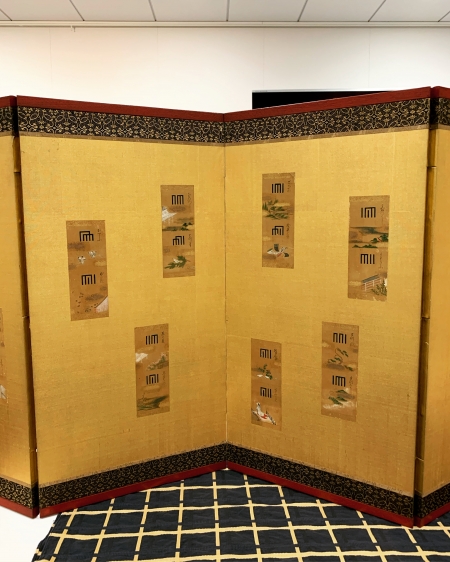人の付属物
普段の生活の中に実用としての屏風が家にある人は少ないだろう。屏風と言えば、鑑賞用として、美術品としてのイメージが強いが、普段の生活の中で実用として使われることがある。
昔の日本家屋では、6畳や8畳などの和室が襖で仕切るだけで続いており、広く使いたい時はその襖を外して使うことができ、逆に小さく使いたい時には、屏風を立てて、その場所だけを仕切っていた。
日本家屋の続きの和室には、洋室のようなドアは無く、襖や障子で仕切り、壁は4面のうち1面しかない場合が多く、視覚上、明確な出入り口が存在しない。だから、襖や障子を外したりして、洋室よりフレキシブルに使うことができ、さらに、小さく仕切る、出入り口を明確にする、出入り口を隠すなど、細かな対応をするために屏風を使う。
屏風は、昔の日本家屋では、生活に無くてはならない小道具であり、簡単に移動もでき、空間要素のひとつだった。
その屏風に代わるものとして、和室が無くなり洋室ばかりの家では、移動に制限があるが、可動間仕切りとしての機能を持った木製の建具を使うことがある。その可動間仕切りを襖や障子の代わりとみなすこともできなくないが、洋室に障子を使うこともあるので、屏風の代わりと考えた方が素直だろう。
洋室に和の要素を取り入れた結果、木製の可動間仕切りを使うことはよくあるが、やはり屏風よりはフレキシブルではない。それは、移動に制限があるだけではなく、可動間仕切りは建築の付属物であり、屏風は人の付属物であり、その違いによるような気がする。
だから、屏風には仕切りとしての実用の役目の他に、鑑賞や美術品としての役目も負う、それは人が着飾るように。
そう考えてみると、今、建築の付属物と見なされている物を、見方を変えて、人の付属物とすれば、また違ったデザインが見えてくるかもしれない。
"Human accessories"
Few people will find a practical folding screen at home in their daily lives. Speaking of folding screens, they have a strong image as an art object for appreciation, but they are sometimes used in everyday life as practical.
In old Japanese houses, Japanese-style rooms such as 6 tatami mats and 8 tatami mats are just separated by sliding doors.If you want to use it widely, you can remove the sliding door and use it. , Only that place was partitioned.
The Japanese-style room following the Japanese house does not have a door like a Western-style room, but is divided by sliding doors and sliding doors, and often has only one of the four walls, and there is no visually clear entrance. Therefore, you can remove the fusuma or shoji and use it more flexibly than in the Western-style room, and use folding screens to provide small measures such as partitioning small, clarifying the entrance, and hiding the entrance.
Folding screens were an indispensable prop in everyday life in old Japanese houses, and they were easy to move around and were one of the spatial elements.
As an alternative to the folding screen, in a house where there are no Japanese-style rooms and only Western-style rooms, movement is restricted, but wooden fittings that function as movable partitions may be used. Although the movable partition cannot be considered as a substitute for a sliding door or a sliding screen, it may be more straightforward to think of it as a substitute for a folding screen because a Western screen may be used as a sliding screen.
As a result of incorporating Japanese elements into the Western-style rooms, wooden movable partitions are often used, but still less flexible than folding screens. Not only is there a restriction on movement, but the movable partition is an accessory of the architecture, and the folding screen is an accessory of the person, and I feel like the difference.
Therefore, in addition to the practical role as a partition, the folding screen also has a role as appreciation and art work, as if people are dressed up.
If you think so, if you change what you see now as an accessory of architecture and make it an accessory of people, you may see a different design again.

